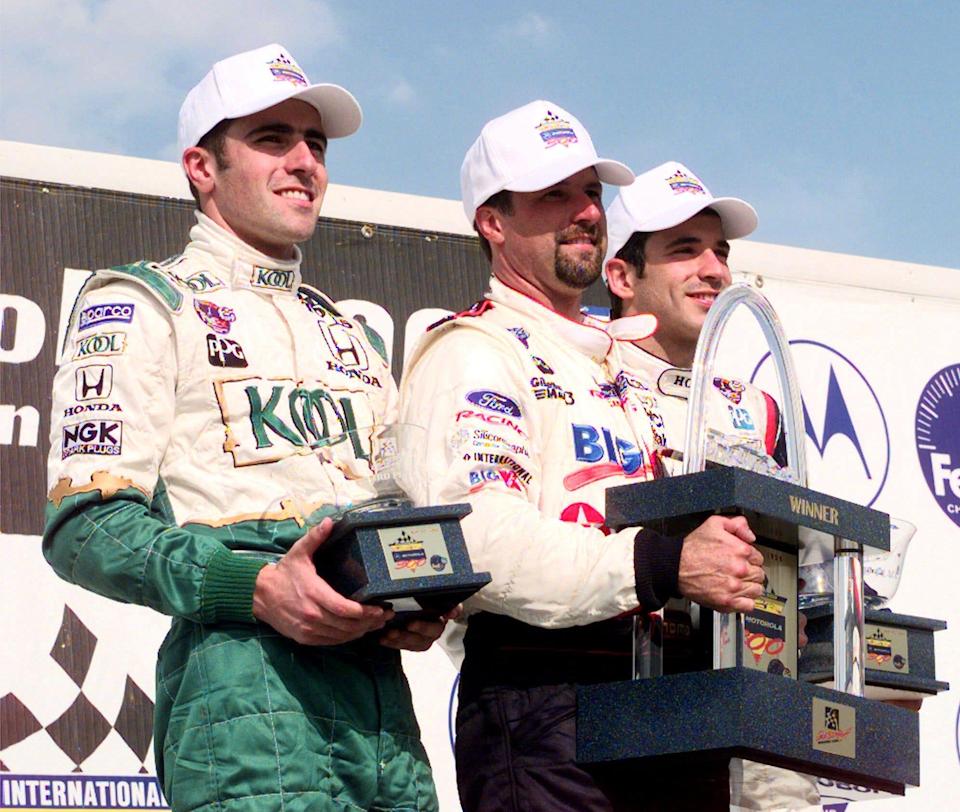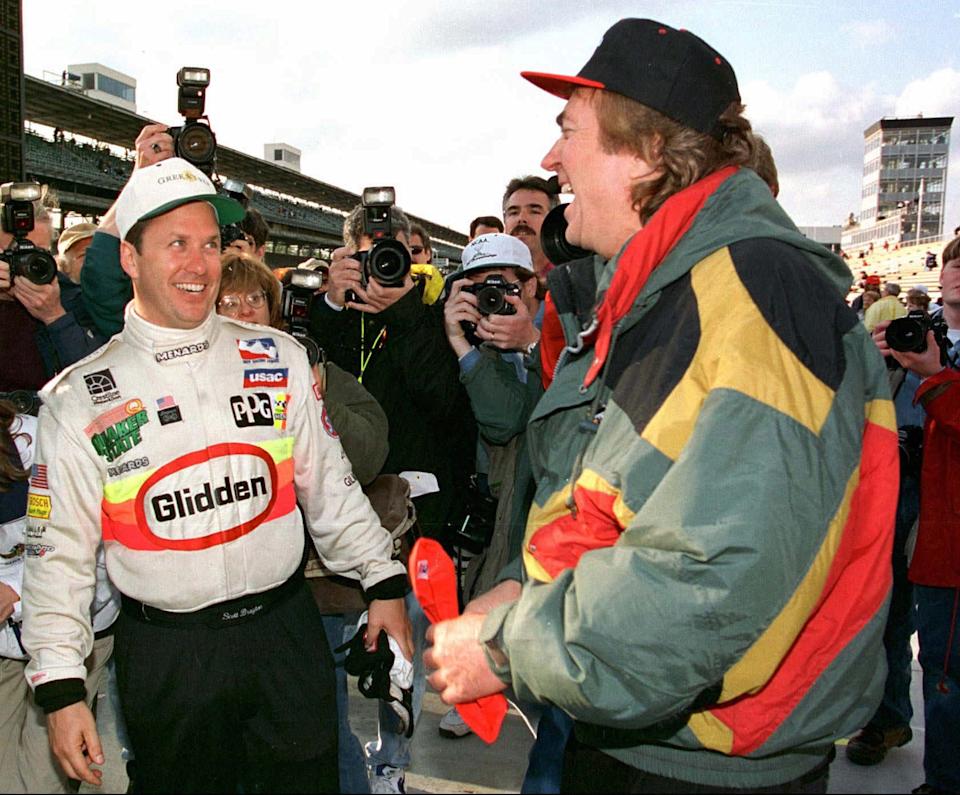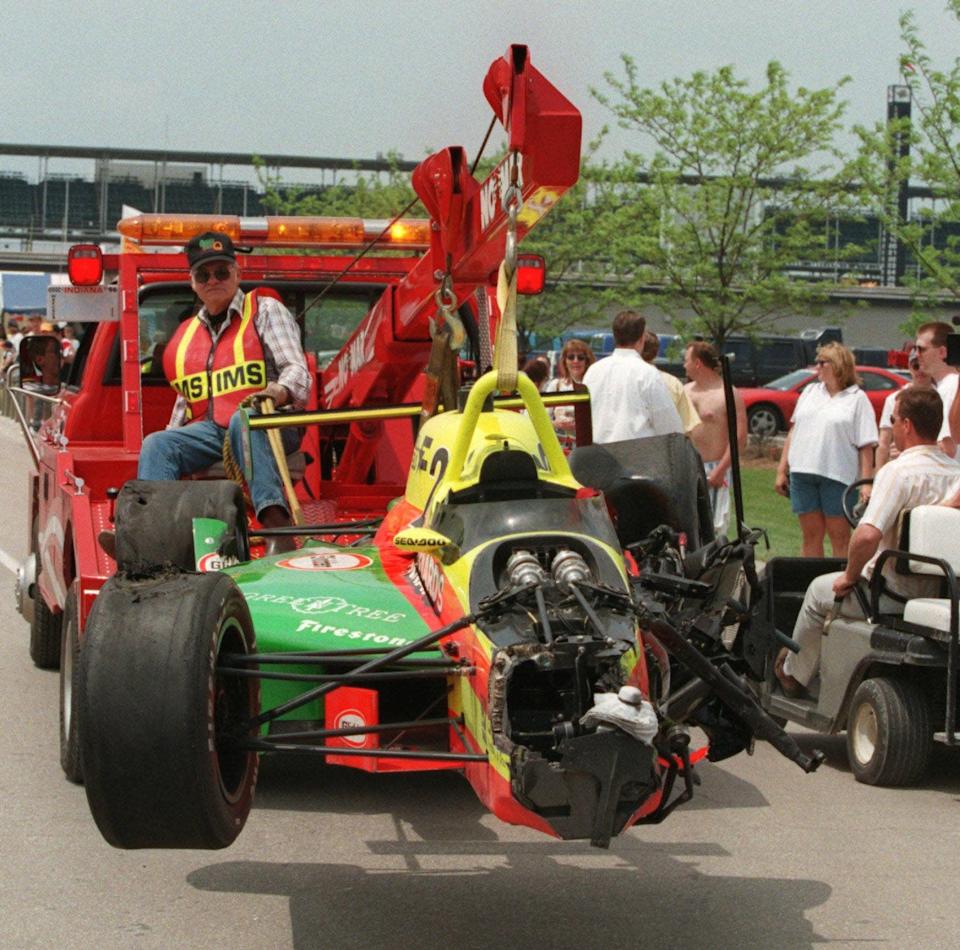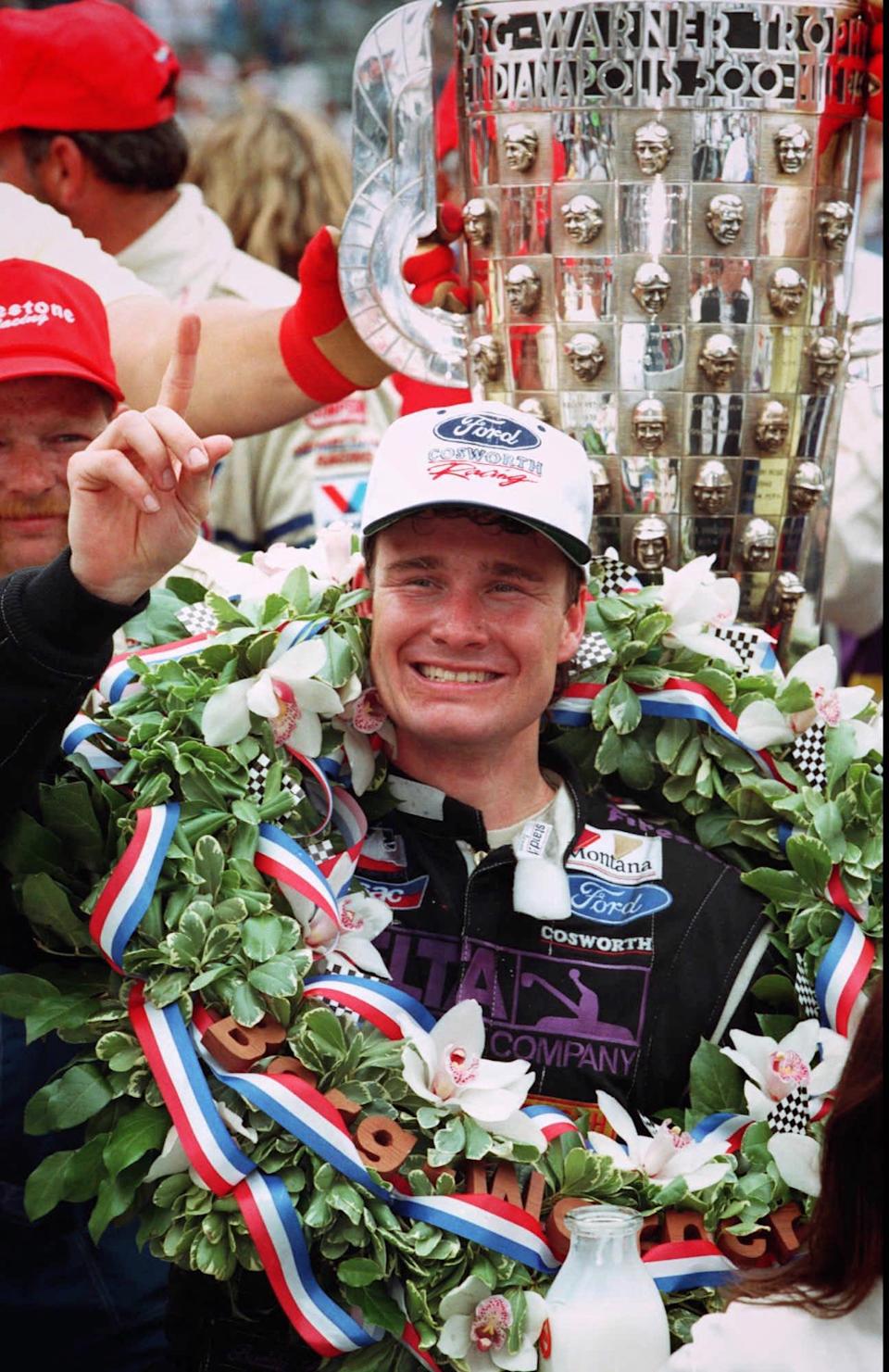Editor’s note: This story was originally published in 2021. We are republishing it ahead of our coverage of the 2022 Indy 500. Some references may be out of date.
INDIANAPOLIS — It takes a lot to rile Mario Andretti. What the legendary racecar driver lacks in size, he makes up for in passion — but almost always positive. He’s a jokester, a “glass-half-full” kind of guy who sees the goodness in just about everything. Not only does it keep the 81-year-old moving, but it keeps him jumping into two-seater open-wheel cars day after day to give fans the time of their lives at 180 mph.
So imagine what kind of mess could pull the Andretti family patriarch to a race track, fully knowing the mere sight of it is going to fill him with disgust and despair. He chose to spend the anniversary of winning the 1969 Indianapolis 500 away from Indianapolis Motor Speedway in 1996, instead going to another race he knew would never live up to the pomp and circumstance of the Memorial Day weekends he’d grown to know and love.
Michigan International Speedway wasn’t even second-best. “It was worse than that,” he says now, 25 years later. “But we’d been left with no choice. We didn’t choose that. We were pushed.
“And I was sad, not only not to be (at IMS), but to have to watch a race up against Indianapolis. But we had no choice.”
Drivers who competed at those tracks that day, May 26, 1996 — 25 years ago this week — firmly believe they had no choice but to be where they were. The dichotomy of the 1996 Indy 500 and U.S. 500, both run that Memorial Day weekend Sunday, was born from “The Spilt” — a product of Tony George’s last-ditch hope to save the prototypical American racecar driver and the oval tracks American open-wheel racing was born on.
That 1996 racing season was the first of more than a decade with two open-wheel racing series running simultaneously. Their existence was better than no open-wheel series, but — and depending upon whom you ask — only barely. CART, run by some of American open-wheel racing’s biggest names — Penske, Ganassi, Rahal — pitted itself against the grandson of the man who helped save the Greatest Spectacle in Racing after World War II, equipped with deep pockets and the historical equity of a race that is bound to outlive them all.
In the mid ’90s, Tony George followed through upon his threat to start a new racing league centered on opportunity for American drivers and the American staple of oval racing with the Indy 500 at the center of it all, afraid that team owners were turning it into just another date on the schedule.
So, with the Indy Racing League scurrying to put the finishing touches on a season-opening race to be held at Walt Disney World and a relatively simple three-race inaugural season, with the Indy 500 as its ‘Super Bowl,’ CART officials prepared their own shot across the bow.
Along with NASCAR’s Coca-Cola 600, which had been created years ago precisely to steal some of IndyCar’s Memorial Day weekend thunder, CART officials would run their own race that Sunday — the U.S. 500 — to try to steal the Indy 500’s date and race distance, swipe most of its talent and stage a coup that has both sides riled up to this day.
“Tony (George), in his own way, thought he was doing the best thing,” Andretti told IndyStar earlier this month. “But he was destroying everything about IndyCar racing. And we’re still paying for that today.”
‘I’m not on the Borg-Warner’
Michael Andretti calls it a “dark day.” Bobby Rahal chooses “silly … embarrassing … a major screwup.”
Lyn St. James doesn’t even want to talk about it at first. “I wish, in a way, you guys wouldn’t bring that back up,” she said. “I know it’s an anniversary … but it’s one you want to forget.” But she relents. Those days are long gone.
Jimmy Vasser remembers CART’s attempt to mimic a full weekend of qualifying, the first step in the series’ convoluted clone of a race.
“And I just remember it was freezing,” he said. “It was like, you know, hell froze over.”
But that merely laid the groundwork for the mess of death, on-track disasters and post-race gaffes to come.
In-depth coverage of the 2021 Indy 500:
Indy 500 practice photos: Drivers take to the oval for the first day of Indy 500 practice
What is a pace car? What to know about the Indy 500 pace car and driver
Scott Dixon: 18-race winless streak has Scott Dixon tempering Indy 500 expectations
Doyel: How did Jimmie Johnson end up in the 2022 Indy 500? ‘Nobody knows this part’
What each driver IndyStar spoke to about that day 25 years ago remembers distinctly is the frustrating feeling of being trapped, caught in the middle of quasi-political warfare none of them wanted to be part of, but all of them were arguably most-affected by.
For St. James, who made her name racing sports cars and drove in her first Indy 500 in 1992 as the second driver who is a woman, siding with George and the Indy 500 was a no-brainer. Similar to the struggle today’s drivers still deal with, the few sponsors she was ever able to muster were only interested in being one of the stickers on her car for the largest single-day sporting event in the world.
Keeping them for other events to help fill out her schedule was the product of the premier bargaining chip she held: the Indy 500. Desert that, and she might as well call it a career.
For Arie Luyendyk, the choice was similarly personal, but with goals altogether more lofty. Since his first win at IMS in 1990, the Dutch driver had finished 2nd, 3rd and 7th, while starting 4th and 8th the other two times. He craved the way winning a second 500 would set him apart in the record books. Only 14 drivers had won it multiple times.
“It was so important to me that I could run the Indy 500,” he told IndyStar this month. “I was at the tail-end of my career, and I just always had that strong urge to win it a second time.”
For guys like Vasser, Rahal, the younger Andretti and others, the decision was just as easy. Rahal, the 1986 Indy 500 winner, was driving for his namesake team at the time, while Vasser and Andretti held cushy rides with Chip Ganassi Racing and Newman/Haas Racing, respectively. And as much as the two adored, revered and longed to win the Greatest Spectacle in Racing, that passion didn’t outweigh what had to been seen as a purely business decision.
Choosing to leave a top team to compete in a series whose season was only three races long and in an Indy 500 field that included an eye-popping 17 rookies in 1996 was what you might call “career suicide” to drivers with aspirations of going down in history as one of the best ever.
“There’s just no way you could do that,” Michael Andretti said. “At that point, everything was bigger in CART. All the manufacturers were there, and they really dictated a lot. And to us, (the 1996 Indy 500 field) was a bit of a joke because there’s guys out there that really shouldn’t have been in the field.


“In the end, it just was a dark time for me because it started this trend of five years that I missed having a shot at winning the race, and I may have had a really good shot at winning one of those races because I’d been so competitive on ovals at that point. Some of us drivers, we kinda got caught in the middle of it, all the politics, and it wasn’t very fair that we lost our chances to try and win this race.”
For Vasser, the ’96 season was a coming-out party of sorts. In his first season running for Chip Ganassi Racing, Vasser managed four podiums and finished 8th in the season-long standings. But the following year, he caught fire, winning three of the first four races. Entering race day for the U.S. 500 at Roger Penske-owned Michigan International, he was starting on pole, poised to win his first 500-mile race — one of three he would go on to win during his career that would come to a close in 2008.
“But that all just seems to go unnoticed, because none of them were the Indy 500,” he said. “CART tried to make these races these $1 million-purse events, and I won three of them in my career, but I’m not on the Borg-Warner.”
A black cloud over IMS
What was already a chaotic, confusing month, when St. James remembers everyone around her wanting to talk about anything but the actual on-track product, quickly turned somber leading into the second weekend of qualifying.
The weekend before, Luyendyk fought through a myriad of engine issues to post a late four-lap run of 233.390 mph, including a best lap of 234.742 mph, to take over pole from Team Menard’s Scott Brayton, before Brayton and his team officials elected to pull their car from the field and attempt to requalify a backup car instead. A four-lap average of 233.718 did just that.


With less than 20 minutes to spare on Pole Day, Brayton crossed the finish line, and at 6 p.m., he officially accepted the pole position for the 1996 Indy 500. Later in the evening, Luyendyk’s run that set him in the middle of Row 1 would be thrown out, his backup car coming in a few pounds under the minimum weight.
Six days later, Brayton’s right-rear tire blew during practice just as he was entering Turn 2. Immediately sent spinning, he made hard contact with the outside wall and was found unconscious by the track safety team. He was transported immediately to Methodist Hospital, but was pronounced dead within the hour, due to a basilar skull fracture.
St. James was speaking at a luncheon for an arthritis organization early that afternoon, having already qualified her car the weekend before.
“But finding out what happened to Scotty just totally took the wind out of my sails,” she said.
She had planned to go out later that afternoon to scrub some tires over a handful of on-track runs, but told those around her, “I can’t get the loss of Scotty out of my head. I can’t strap myself in a racecar with the way my head’s at. And I can’t tell the crew. I don’t want them to think I’m weak.”


Danny Ongais served as Brayton’s substitute driver and had to start in the back of the field. Rookie Tony Stewart took over pole for the ’96 500, where he finished 24th, but Stewart would recover quickly to take the 1996-97 IRL title in his second of just three full-time open-wheel racing seasons before jumping to NASCAR.
As one of more than a dozen rookies in that race day field, Stewart, then 25, remembers the weight of the moment burdening him more than anything he’s experienced since. A rookie starting on pole for the biggest race in the world, one that in some ways had lost appeal and would be more picked-apart than any before or after, was a lot to put on a young Stewart.
“That’s the closest I’ve ever been to throwing up before a race,” he said. “The nerves were at a level that I had never seen before in my entire life in any form of motorsports leading up to my first Indy 500.
“It was extremely hard to stay composed, knowing what was coming up.”
‘Who needs milk?’
Stewart’s butterflies spread across the grid to create a mess of the first 20 laps. Hideshi Matsuda stalled on the front-stretch during the pace laps and had to be pushed into the pits. Johnny Unser had transmission issues and dropped out before the green flag fell. Mark Dismore did a half-spin in Turn 1 on Lap 1, bringing out a brief yellow due to debris on track.
On the restart, Scott Harrington came upon the back of the field too quickly, locked his brakes and spun himself, nearly taking out three cars in the process but managing to avoid the wall. Shortly after, Paul Durant blew an engine on the back-stretch on Lap 11, only to spin in his own leaking fluid. Ongais would also spin before Lap 20 to cap the circus of errors.
Six hours north in Michigan, though, things arguably went worse. On the final pace lap with Vasser on pole and slowing bringing the field up to speed, Adrian Fernandez was hugging the CGR car’s right side and, coming around a corner, nudged Vasser’s right-rear tire, sending the eventual race-winner into a 90-degree right turn straight into the side of Bryan Herta’s Team Rahal machine.
The accident collected nearly a dozen cars and lives in infamy in YouTube clips. It’s brought up every time a pre-green flag IndyCar crash occurs, whether it’s Race 2 at Texas Motor Speedway this year or in the series’ iRacing Challenge a year ago.
[embedded content]
2022 Indy 500: Autograph, IMS unveil Indy 500-themed NFT drop featuring commemorative 2022 ticket
Indy 500 blackout: 90% of grandstands sold for Indy 500 but IMS not expecting sellout, lift of local blackout
“Here, we’re talking about the greatest drivers, and they couldn’t even start the race. Boy, that was pretty silly, and really embarrassing in my mind,” Rahal said.
Added Vasser: “Some people say it was because we tried to go three-wide, but that had nothing to do with it. The track is actually wider than (IMS). It simply shouldn’t have turned out that way. It was just a real blemish on that day, just a real disaster.”
The other side that Rahal, Vasser and others will point to is that, due to CART rules, the race had not yet officially started and drivers whose cars were damaged could hop into their backup cars for the race’s restart about an hour later — something that would not be possible today in IndyCar. In a way, it points to a more team-friendly system the team owner-owned and operated series boasted about.
Only Fernandez wasn’t able to restart the race, and in the end, Vasser won the 250-lap event watched by a nearly-packed Michigan venue that had the fan vibrancy many say IMS lacked that day.
In Victory Lane, Vasser was overheard saying what he says now was meant to be an off-the-cuff comment to his crew members as they high-fived and hugged and hollered.
“Who needs milk?!” a mic caught him saying, referring to IMS’s longstanding tradition of handing the Indy 500-winner a bottle of milk to chug, and eventually douse themselves on the Victory Podium.
“And then when the team got back to the shop on 38th Street after the race, there was a milk bottle sitting by the gate.”
That line of his was spread across newspapers around the country and certainly taken to heart by the local Indy 500-diehards, who would never let him hear the end of it as long as he continued to drive — most vehemently in 2000 for his Indy 500 return.
“I joked and said, ‘My doctor said I needed some more calcium in my diet’,” he says nowadays. “I certainly never meant that Michigan was the better place to be.”
‘This is bigger than any of us’
Back at IMS, Stewart led 44 laps early from pole, but retired 82 laps in with a blown engine. By just past the halfway mark, only six cars were on the lead lap, and by Lap 150, less than half the field was still running. By the closing laps, the 500-mile race had turned into a fuel-conservation battle, with Buddy Lazier finding himself able to run in full-rich mode while others tried to ration.
With fewer than 10 laps to go, Lazier made the race-winning pass on Davy Jones, who had led 46 laps. A late caution with four laps to go gave Jones the ability to battle for the win down the stretch, but lapped traffic separated the two, helping give Lazier his 0.695-seconds cushion he needed to come away with the 500 victory — his first IndyCar win of any kind.
Lazier’s win prompted more disdain from the CART contingent, who saw that year’s winner as another mark against George — that he had watered down the field of the Greatest Spectacle in racing by needing to fill a 33-car field with what Vasser compared this month to the NFL’s 1987 season, when teams had to call upon “replacement players” to fill rosters while most of the league went on strike.
Before his 500 win, Lazier’s best finish in the CART championship was 19th (1992). By 1996, he had only three top-10s to his name, and in 1995, he managed just a partial-season program across three teams and finished 27th in the Indy 500.
“I think (Lazier winning) took a lot away from the 500 for sure,” Andretti said. “We were over there watching the greatest race in the world feeling like it’s a bit of a joke.”


St. James, on the other hand, saw that Cinderella story as the month’s only redeeming moment. The bickering, the grandstanding, the comparing of one’s rosters and playing up the other’s mistakes was a poor look for both series — one that wouldn’t cease until CART’s powerhouses began to trickle over to the Indy 500 at the turn of the century. Ganassi’s Juan Pablo Montoya ran away from Lazier with a more than 7-second cushion to win his first 500 in 2000.
“I remember saying, ‘This is bigger than any of us. This race is bigger than any team or driver, whether you went to Michigan or you stayed (at IMS),’” St. James said. “It has a bigger history than any of us individually. Get over it.
“It would be a waste of time to think about what it could have been had ‘The Split’ not happened, because it happened.”
Email IndyStar motor sports reporter Nathan Brown at nlbrown@gannett.com. Follow him on Twitter: @By_NathanBrown.
This article originally appeared on Indianapolis Star: 1996 Indy 500 remembered as ‘dark day’ by Michael Andretti
